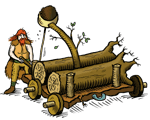Последние темы
Похожие темы
Праздники Исландии

Вход
North Iceland
Страница 1 из 1
 North Iceland
North Iceland
icelandreview.comCulture, natural treasures, and adventure
North Iceland is an expansive, enchanting region, where you can find all of Iceland's attractive aspects: culture and a flourishing society, endless opportunities for entertainment and outdoor recreation, picturesque nature in all directions, and more natural sights than almost anywhere else. Spring, when the sun melts the snow and the land takes on the green of summer, is a time of renewal, travel and being outdoors. Some people go walking, swimming or golfing, while others choose fishing, hunting, riding horses, or adventurous trips on the sea, lakes or rivers. All around, something is offered to suit everyone, such as trips to other towns, out to islands, or into the highlands to view mountains, hot springs, waterfalls, glacial rivers, volcanic craters, extraordinary landscape and other geological features. Highland trips are experiences never to be forgotten. The season of autumn brings its marvellous colours, while winter has its own charm, as winter sports take over, the northern lights dance in the cold sky, and the darkness itself provides inspiration and spiritual uplifting.
Angling and hunting
Many of Iceland's leading salmon and trout streams are located in the North. Fresh and unpolluted, they receive the salmon in summer and provide it with optimal conditions. While the counties named after Húnavatn and Þingey have salmon rivers that are subject to heavy demand, those of Skagafjörður and Eyjafjörður contain productive trout-fishing rivers that are also popular and of high repute. Not to be forgotten are the numerous lakes near lowland farms, among lofty mountains, or up in the highlands, where fishing lakes replete with energetic Arctic char and muscular brown trout provide a dream catch for the fisherman. Not much could provide more delight than standing in the colourful Northern outdoors, casting for fish and tanking up on fresh energy and optimism. Those wishing to fish on the deep-blue ocean can opt for sea angling, with departures from several harbours. Besides the benefits to health of such trips, they always provide lasting memories.
Walking and the mountains
North Iceland has numerous age-old trails, of which many have in recent years been mapped. The landscape, length and difficulty varies, so that the possibilities are endless. In Húnavatn county, walking routes lie both along the sea and into the mountains. At Skagaströnd there is a marked path onto the mountain of Spákonufell. For a romantic walk, try going onto the island of Hrútey in the glacial river Blanda, then following the river to its mouth. Skagafjörður offers pleasant routes into Austurdalur valley and onto the peaks of Mælifellshnjúkur, Tindastóll and Glóðafeykir, in addition to marked trails through the mountainous terrain between the counties of Skagafjörður and Húnavatn. Passing rugged higher ground, spectacular routes connect Siglufjörður, Héðinsfjörður, Ólafsfjörður and Dalvík. Just beside Akureyri, the Kjarni woods are known as an outdoor paradise, and trips into Fjörður are incomparable. Anyone would feel challenged by the paths at Jökulsárgljúfur, while Langanes has attractions few walkers today have ever seen.
Horses and roundups
Horsemanship is born into the people of the North. In the countryside, most people have horses, and a great many do even in the towns. Everywhere there are horse rentals offering riding trips, so trying out the small but very strong Icelandic horse is no problem at all. Everyone will enjoy it, regardless of the weather. It is not surprising that these horses were called man's most necessary servant, considering the total lack of roads in former times. Leading through the untouched, charming nature of North Iceland, riding trails follow the coast, wind into the scenic mountains, or revive the use of age-old trails with varied history. Experiencing an autumn roundup by the owners of free-ranging horses is no less of an adventure. Sitting on the corral fence and watching the action, you will see excitement, hear singing, and find happiness in every face. Many places in North Iceland have special exhibitions that introduce travellers to the Icelandic horse, and events related to riding and raising horses are always on the increase.
Culture
Many of the best-known Icelandic sagas occurred and were even written down in North Iceland. Hólar, home to one of the country's oldest rock churches, was for seven centuries the seat of one of Iceland's two bishops and thereby one of the country's two educational centres. Today, archaeologists are investigating remains at many sites in the North to cast more light on the region's remarkable history. In every area, there are old buildings, churches and museums connecting the present with the past; in fact, Iceland's oldest wooden building, Hillebrandtshúsið, is at Blönduós. Just a few of the region's most significant museums are Glaumbær in Skagafjörður, the Folk Museum at Grenjaðarstaður, Akureyri Museum and the Akureyri Arts Centre, which includes the internationally renowned Akureyri Art Museum. Newer museums that have already attracted special attention are the Icelandic Emigration Centre at Hofsós, the Herring Era Museum at Siglufjörður, the Textile Museum at Blönduós, and the Whale Museum at Húsavík, to name but a few. Come to North Iceland and feel the breath of its history and culture.
Natural pools, warm springs and swimming
After a demanding hike or other healthy activity in the nature of the North, there is nothing better than relaxing in warm water and feeling the exhaustion flow out of your body. Geothermally-heated swimming pools are found in every town and even at many rural spots, with the major ones offering several swimming lanes, hot tubs of different temperatures, pool fountains and a sauna. On the other hand, small pools also have their individual charm and certainly renew one's body and soul. In a few locations, the North Iceland environment has provided a truly natural bath, where the traveller can enjoy the water in the middle of expansive scenery, under the open sky. Examples of this are Hveravellir and, just north of Sauðárkrókur, the seaside pool made of rock and associated with the saga hero Grettir. At Laugafell, near the glacier Hofsjökull, Akureyri Touring Club has constructed an outdoor pool. Nor are the Mývatn Nature Baths to be forgotten -- a must for relaxing in the comfort of steam, a hot tub or the warm lagoon itself.
Winter recreation
With its numerous skiing areas, it is not surprising that North Iceland has been called the land of winter adventure. In addition to Akureyri's Hlíðarfjall, known throughout Iceland, there are first-class skiing areas at Sauðárkrókur, Siglufjörður, Ólafsfjörður, Dalvík and Húsavík, as well as a short slope at Krafla. Snow scooters are rented out at a number of places, and trips on cross-country skis are offered for instance from Ólafsfjörður to Héðinsfjörður. From Grenivík, skiers are taken up the mountain by a snow packer, while at Mývatn you can hire a snow scooter and cross-country skis or enjoy the sports options in the Arctic Garden on the lake ice. North Iceland's skiing slopes provide fabulous views, not to mention the northern lights. What could be more enjoyable than spending Christmas and New Year refreshing oneself in the embrace of towering, snow-clad mountains? The nights become long and dark, so people take advantage of them through the þorrablót feasts of mid-winter.
Spring and autumn
Springtime wakes nature from its winter sleep. Plants begin to grow and the meadows turn green, as salmon head up the rivers and birds migrate back to their North Iceland nesting grounds. Farmers watch over ewes giving birth and nursing their lambs, and fishermen fix up their boats. People feel brighter, get out their summer clothes and generally think of travel, whether it means a boat trip on the sea, a hike into the mountain range, or a tour on horseback. Nor is magic lacking in the autumn, when splendid colours and stillness affect everyone touring the North. As the sheep return from the mountains, people gather at roundups to help the farmers sort them, with everyone singing and enjoying themselves the whole time. Another item on the season's agenda is picking berries for jelly, jam or juice, or for the sheer pleasure of it. Please feel welcome to try our North Icelandic autumn; September is a good month to start with. As winter draws on, cultural presentations are frequent, particularly a wide assortment of musical events.

Bivaliy- Уважаемый Тролль

-
 Количество сообщений : 262
Количество сообщений : 262
Географическое положение : Исландия
 Re: North Iceland
Re: North Iceland
icelandreview.comAdventures
No matter which way you turn, unforgettable adventures are waiting right around the corner -- you just have to choose. By travelling along the coast, you will get to know life in the fishing villages and have opportunities for trips to islands off the North coast, for viewing nature or island life. Those who want still more excitement and speed can select glacier river rides on Skagafjörður's Austari Jökulsá or Vestari Jökulsá, followed by relaxation in a hot tub with fellow travellers to talk about the day's thrills. Raufarhöfn offers kayak and canoe trips, while in the other direction the highlands beckon. Do not hesitate to answer their call, so as not to miss the grandeur of untouched nature stretching to the horizon: Iceland's great highlands. One route passes through Blöndudalur and crosses Kjölur to South Iceland, via the warm springs of Hveravellir, once home to an outlaw. Especially worth mentioning are the tours to Herðubreið, Askja and Hvannalindir. Trips to such jewels of the Icelandic highlands are sure to be an unforgettable experience.
Wildlife
The richly varied fauna of North Iceland, not to mention the flora, provides every nature lover with sights that please. Hindisvík on Vatnsnes is a major seal breeding ground, where the protected seals are so unusually tame that it is easy to observe them from land or a kayak. Skagi presents a large variety of birds, while farther to the east a good option is to combine island tours of Skagafjörður with birdwatching at Drangey and Málmey. In the same way, boat rides in Eyjafjörður combine conveniently with viewing the wildlife there. Multitudes of seabirds nesting in the cliffs make Hrísey and Grímsey their island homes. While Húsavík has the Whale Museum and is the centre for whale watching from Icelandic shores, Dalvík also offers excellent whale-spotting excursions. There, the valley of Svarfaðardalur is furthermore renowned for its varied birdlife. This can also be said of Mývatn; in fact, the world offers no better place for spotting ducks. Melrakkaslétta is reputed to be the terrain of the Arctic fox, while Langanes parades one of Iceland's main nesting sites for the gannet. Take time for an unstressed stop by the sea, where life and the breakers are endless.
Natural treasures
North Iceland nature attracts people of all ages. In Húnafjörður, the rock arch of Hvítserkur towers just off shore; far to the south, Hveravellir adds colour to the highlands with one of the country's largest geothermal fields. The islands of Málmey and Drangey exude folklore, while the people of Eyjafjörður boast of their magnificent mountains and prosperous farms. The two Þingey counties present nature that is so diverse and has so many sights, you would be hard put to find more natural masterpieces elsewhere. Take, for example, the waterfalls of Goðafoss and Dettifoss, the latter Europe's mightiest. Downstream from Dettifoss, explore Jökulsárgljúfur, one of the country's most awe-inspiring canyons, and view the Hljóðaklettar formations and Ásbyrgi, shaped by the rushing waters of the Jökulsá. Far to the south, Askja epitomises calderas and volcanoes. Mývatn and its entire environs are world-famous for their beauty, including the wondrous cliffs of Dimmuborgir.
North Iceland towns
Society and the economy have many faces. Whereas agriculture is the mainstay of rural areas, the towns depend upon fishing, industry, trade and a range of services, with each village having its own characteristics -- though all proving hospitable hosts. The availability of food, accommodation and recreation at every stop makes hopping between the villages informative and fun. From the capital of North Iceland, Akureyri, it is only a short journey to Húsavík or to Dalvík, Ólafsfjörður and Siglufjörður, whose communities hug the mountains. Nor is it much farther to Sauðárkrókur and the villages in the Húnavatn counties. In every case, the residents are lively and ready to celebrate. The citizens of Akureyri offer entertainment through their Family Festival, Dalvík puts on the Great Day of Fish, Ólafsfjörður has its Music Festival, Húsavík the Pier Festival, Siglufjörður its Folk Music Festival, and Skagafjörður a Culture and Arts Festival.
Golf
The basis of well-being and a long life is getting outdoors and exercising. The popularity of golf has been rising steadily, as golfers manage to blend the enjoyment of sport, being outdoors, and exercising. The people of the North have worked hard to build as many high-standard golf courses as possible, so that now one six-hole course is available at Reykjahlíð and nine-hole courses are common, being offered at Blönduós, Skagaströnd, Sauðárkrókur, Siglufjörður, Ólafsfjörður, Dalvík, Húsavík and two locations in Eyjafjörður. Finally, Akureyri has an eighteen-hole course -- the most northerly full-sized course in the world -- and there are putting greens at Leifsstaðir and Kópasker. There are a number of competitions, of which the outstanding Arctic Open at Akureyri occurs under the midnight sun around the summer solstice. Come to the North and loosen your limbs by golfing as you please
Akureyri The Capital of the North - is a lively little town sheltered from the ocean winds by mountains on three sides. Late 19th-century wooden houses impart a sense of history to the region, and the twin spires of a modern Lutheran church - rising on a green hill near the waterfront - provide a focal point. The church is named after Akureyri's native Matthías Jochumsson, the poet who wrote Iceland's national anthem in 1874.
The Arctic Botanical Gardens: Akureyri's Arctic Botanical Gardens are the northernmost botaical gardens on the planet flourishing with more than 400 species of Icelandic flora, including rare Arctic and foreign plants.
Mattiasarhús: The house where the poet Matthías Jochumsson once lived, now a museum reflecting the life and work of this master poet. Akureyri Natural History Museum Displays specimens of all the bird species nesting in Iceland.
Laxdalshús: A beautifully restored House dating from the 18th century, now the residence of a Lutheran priest, is the oldest home in Akureyri. Visitors can explore the grounds and see the interior. Scenic drives from Akureyri In June and July, a drive north from Akureyri along Route 82 promises breathtaking views of the coast drenched in the midnight sun.
Húsavík: A charming fishing village with a uniquely beautiful timber church. Handy to nearby winter sports, it is also a base for summer hiking. Whale watchers have had amazing success on tours, which take place aboard restored oak boats.The Húsavík Whale Centre has exhibits on Iceland's history as a whaling nation and on the biology of these behemoths.
Lake Mývatn: The true jewel of the north region is lake Mývatn surrounded by fascinating eruptive craters, as well as spectacular bird life. More duck species nest there than by any other lake on Earth, and the harlequin duck and barrow's golden eye exist nowhere else in Europe.
Godafoss: The Waterfall of the Gods. Rivers with impressive waterfalls traverse the area around Mývatn. Godafoss is named after a Pagan leader of Parliament from the year 1000 that tossed his religious icons into the waterfall to signal his acceptance of Christianity.
Ásbyrgi: A giant rock formation caused by a subsidence in the landscape. According to a legend, this hollow is a giant hoof print left by Sleipnir, the eight-legged horse of the ancient Norse god Ódinn.
Dettifoss: In many people's opinion, Dettifoss is the most spectacular waterfall in Iceland. With a height of 45 metres, 100 m wide and an average water flow to the volume of 200 cubic metres per second, it is the most forceful waterfall in Europe. Dettifoss also has an impressive power to attract tourists from far and wide. The waterfall is only 135 km from Akureyri, so a visit from the capital of North Iceland makes an ideal day outing. It has been said that after seeing Dettifoss, you can never be the same again!
Cruises: A ferry plies to and from the island of Hrísey island, the pearl of Eyjafjördur fjord, home of Galloway cattle breed and out to Grímsey Island, 40 km (25 mi) offshore straddling the Arctic Circle.
Saudárkrokur town: In summer, boat trips from the small coastal town Saudárkrokur to Drangey and the Málmey Islands offer striking views of the fjord and bird life.
Hólar: On the eastern side of Skagafjördur fjord, off Route 75, stands the 18th-century stone cathedral containing beautiful and priceless religious artefacts. Hólar has played an important role in Icelandic history from the time of settlement.

Bivaliy- Уважаемый Тролль

-
 Количество сообщений : 262
Количество сообщений : 262
Географическое положение : Исландия
Страница 1 из 1
Права доступа к этому форуму:
Вы не можете отвечать на сообщения

» FAQ или часто задаваемые вопросы
» Шторм на Ладоге
» У моря в апреле
» Ты будешь жить
» 67-я параллель
» Тиманский овраг
» Отель "Ореанда"
» Карельские рассветы
» Альма-Матер